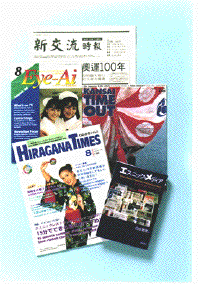 Over 100 Papers and Magazines
Over 100 Papers and Magazines
There are roughly 1.35 million people registered as foreigners living in Japan. The number has nearly doubled in the last 20 years.
MULTICULTURAL PUBLICATIONS:
Foreigners in Japan Find an Oasis of Information
SEPTEMBER 19, 1996
 Over 100 Papers and Magazines
Over 100 Papers and Magazines
There are roughly 1.35 million people registered as foreigners living in Japan. The number has nearly doubled in the last 20 years.
Excluding information material put out by local authorities and volunteer groups, there are now over 100 newspapers, magazines, and other publications operating on a commercial basis catering to ethnic minorities in the respective languages. These publications form an oasis of information in a culture where many foreigners cannot follow the local media.
Most of these ethnic-minority publications were founded in the 1980s or later. They mainly cater to people of Asian and Latin American ancestry who came to Japan to work. They are published on a weekly, monthly, or quarterly basis, and their circulation ranges from under 1,000 to over 50,000.
Regarding content, many carry reports from the home country and international as well as Japanese domestic news. They also devote many pages to information about the ethnic communities in Japan that they represent. And many publications go to great lengths to cover entertainment and sports in the home country.
Japanese History and Culture
International Press is a Portuguese-language weekly magazine founded in 1991 and pitched at Brazilians. It sells itself on a content mix that includes a broad range of news from inside and outside Japan and articles and special features about Brazil.
It has won great popularity among Brazilian residents of Japanese ancestry, whose ranks swelled in the early 1990s. Its circulation is thought to be as high as 55,000.
There are also several papers and magazines catering to Filipinos. Initially they came out in English and Tagalog, but recently the proportion of articles in Japanese has risen in the light of the increase in marriages between Japanese and Filipinos.
Pinoy, a monthly magazine started up in 1994, now has a circulation of 8,000. It is edited in English, Tagalog, and Japanese. The name means Filipino.
If you are a Chinese-speaker in Japan, there is plenty to read. This ethnic group is the country's second-largest, and claims around 220,000 members. They are served by over 30 papers and magazines in Chinese. Two of them have official circulations in terms of copies published of at least 50,000: Shin Koryu Jiho (New Com Times), a monthly founded in 1991 with a circulation of 72,000, and Ryugakusei Shimbun (Foreign Students News), founded in 1988 and published every two weeks. This magazine says its circulation is 55,000.
High circulations in terms of copies published are also enjoyed by newspapers and magazines catering to English speakers. Since its first edition in 1986 the bilingual monthly language-learning aid Hiragana Times has achieved a circulation of 83,000. In addition, there are English-language papers put out by overseas groups and the major Japanese national dailies.
Recently, ethnic-minority publications have begun to carry more features about Japan, including reports on tourist areas, history, and culture. This trend is believed to reflect increasing reader interest in interaction with Japanese society.
In the monthly Kaibigan (Friend), founded in March 1991 for Filipinos in Japan, there has apparently been a good response to columns about karaoke and other elements of Japanese popular culture, and to articles introducing the cuisine of both countries.
Making Japan Multicultural
The role of these minority publications has attracted the attention of academics. Professor Shigehiko Shiramizu of Musashi University has published "Esunikku Media" (Ethnic Media), a collection of his own writings and those of other commentators that he has edited.
In it, he says that while ethnic-minority publications are first and foremost tools of the racial group in question, their existence still has significance for the Japanese. He points out that they help diversify Japanese culture by enriching it with perspectives and understanding that are absent at the ordinary conversational level and in the nation's media.